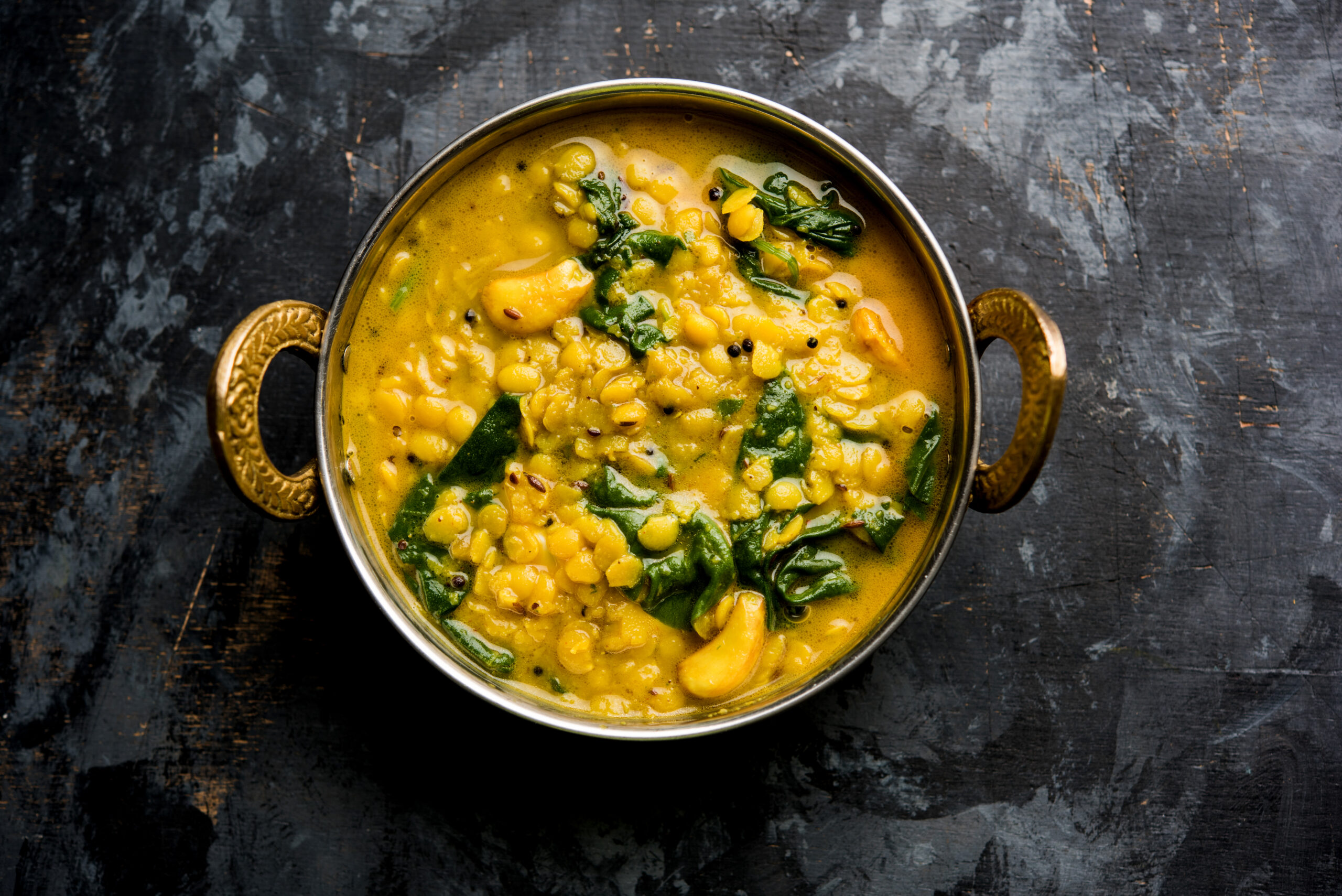
A one-pot dinner that is fresh, healthy and easy to make. It’s also a complete meal by Ayurvedic standards, with all six tastes included.—sweet, sour, salty, pungent, bitter and astringent. Eat it slowly, and see if you can find all six.
A balanced meal directly nurtures the body, mind, senses and spirit. Food gives strength, sustenance, energy and radiance. Ayurveda identifies 6 tastes by which all foods can be categorized. Sweet, sour, salty, bitter, pungent and astringent. Most grains and legumes (like lentils) are sweet. The sweet taste naturally increases bulk, moisture, and weight in the body. For this reason, it is excellent for building the body’s tissues of plasma, blood, fat, muscles, bones, marrow and reproductive fluids. The sweet taste also increases saliva, soothes mucous membranes and burning sensations, relieves thirst and has beneficial effects on the skin, hair and voice.
The sour taste is hot, light and moist and is commonly found in citrus fruits like lemons and limes. This taste stimulates the digestion and circulation as well as elimination. It energizes the body, strengthens the heart, relieves thirst, maintains acidity, sharpens the senses and helps extract minerals such as iron from food. It also nourishes the tissues (except reproductive tissues).
The salty taste is hot, heavy and moist. It is found in any salt, sea vegetables and foods like nuts, chips and pickles. Due to its drying quality in the mouth, it may seem counter-intuitive to think of the salty taste as moistening. However, the salty taste lubricates tissues, improves digestion, and liquefies heavy mucous. It also maintains mineral balance, aids in the elimination of wastes and calms the nerves. Due to its tendency to attract water, it also improves the radiance of the skin and promotes overall growth in the body.
The bitter taste is light, cooling and dry. Often found in green leafy vegetables (such as spinach, kale and green cabbage), other vegetables (including zucchini, and eggplant), herbs and spices (like turmeric, fenugreek and dandelion root), coffee and certain fruits. The bitter taste stimulates the appetite and is a powerful detoxifying agent. It also has antibiotic, anti-parasitic and antiseptic qualities. It helps in reducing weight, water retention, skin rashes, fever and burning as well as nausea.
Pungency describes the hottest taste of all the tastes and is found in certain vegetables (such as chili peppers, garlic, and onions), and in spices (like black pepper, ginger, and cumin). The pungent taste stimulates digestion, clears the sinuses, promotes sweating and detoxification, dispels gas, aids circulation, improves metabolism and relieves muscle pain.
The astringent taste is dry, cooling and heavy. It is the least common of all six tastes and can be found in legumes – such as lentils, fruits (including cranberries, pomegranates, pears, and dried fruits), vegetables such as (broccoli, cauliflower, artichoke, asparagus and turnips). Also found in grains such as rye, buckwheat and quinoa and spices and herbs (including turmeric and marjoram), coffee and teas. The astringent taste is incredibly drying and stops bleeding, absorbs water, tightens tissues, dries fat and heals skin wounds like ulcers and mucous membranes. The astringent taste also has antibiotic and antibacterial effects.
As this meal contains all 6 tastes, you can see how we are using food as medicine in this dish.
Legumes: Low in calories and high in nutrition, lentils are the perfect legume to eat all year round. Lentils help reduce blood cholesterol since it contains high levels of soluble fiber. Lowering your cholesterol levels reduces your risk of heart disease and stroke by keeping your arteries clear. Several studies have shown that eating high fiber foods like lentils reduces your risk of heart disease. Lentils are also a great source of folate and magnesium, which are big contributors to heart health. Folate lowers your homocysteine levels, a serious risk factor for heart disease. Magnesium improves blood flow, oxygen and nutrients throughout the body. Low levels of magnesium have been directly associated with heart disease, so eating lentils will keep your heart happy! The insoluble dietary fiber found in lentils helps prevent constipation and other digestive disorders like irritable bowel syndrome and diverticulosis. Adding to the many benefits of fiber, soluble fiber traps carbohydrates, slowing down digestion and stabilizing blood sugar levels. This can be especially helpful for those with diabetes, insulin resistance or hypoglycemia.
Of all legumes and nuts, lentils contain the third-highest levels of protein. 26 percent of lentil’s calories are attributed to protein, which makes them a wonderful source of protein for vegetarians and vegans. Lentils increase steady, slow-burning energy due its fiber and complex carbohydrates. Lentils are also a good source of iron, which transports oxygen throughout your body and is key to energy production and metabolism and although lentils include all these beneficial nutrients like fiber, protein, minerals and vitamins, they are still low in calories and contain virtually no fat. One cup of cooked lentils only contains about 230 calories, but still leaves you feeling full and satisfied.
Spinach: Low in fat and even lower in cholesterol, spinach is high in niacin and zinc, as well as protein, fiber, vitamins A, C, E and K, thiamin, vitamin B6, folate, calcium, iron, magnesium, phosphorus, potassium, copper, and manganese. In other word, it’s loaded with good things for every part of your body! The abundant flavonoids in spinach act as antioxidants to keep cholesterol from oxidizing and protect your body from free radicals, particularly in the colon. The folate in spinach is good for your cardiovascular system, and magnesium helps lower high blood pressure. Studies have shown that spinach helps maintain vigorous brain function, memory and mental clarity. Spinach is also one of the best sources of dietary magnesium, which is necessary for energy metabolism, maintaining muscle and nerve function, heart rhythm, a healthy immune system and maintaining blood pressure. Magnesium also plays a part in hundreds more biochemical reactions that occur in the body. Those with digestive disorders, alcoholic, older adults and individuals taking medications such as antibiotics and diuretics are more likely to have a magnesium deficiency and should consume more leafy greens like spinach.
Carrots: Carrots cool quality and mild bitter taste acts to purify the blood. Strongly alkalizing, carrots also have a cool and relaxing effect on the eyes. Beta-carotene, which gives carrots their bright orange color, is metabolized into vitamin A in the presence of bile salts in the small intestine. Vitamin A nourishes the liver, and purifies the blood. These actions improve vision, complexion of the skin, and generally reduce inflammation. Carrots help to make the skin noticeably softer, smoother, and firmer.
Fennel: Fennel seeds contain numerous flavonoid anti-oxidants like kaempferol and quercetin. These compounds function as powerful anti-oxidants by removing harmful free radicals from the body, protecting from cancers, infection, aging and degenerative neurological diseases. Fennel seeds have health benefiting volatile essential oil compounds such as anethole, limonene, anisic aldehyde, pinene, myrcene, fenchone, chavicol, and cineole. These oils are known to have antioxidant, digestive, carminative, and anti-flatulent properties. Fennel seeds are also concentrated source of minerals like copper, iron, calcium, potassium, manganese, selenium, zinc, and magnesium. Copper is required in the production of red blood cells, as is iron and zinc is a co-factor in many enzymes that regulate growth an
d development, sperm generation, digestion and nucleic acid synthesis. Potassium is an important component of cell and body fluids that helps in controlling heart rate and blood pressure. Furthermore, fennel seeds are the storehouse for many vital vitamins. Vitamin A, vitamin E, vitamin C as well as many B-complex vitamins like thiamin, pyridoxine, riboflavin and niacin.
Cumin: Cumin is extremely good for digestion and related digestive problems. The very aroma of cumin, which comes from an aromatic organic compound called cuminaldehyde, activates our salivary glands in our mouth, which facilitates the primary digestion of food. Next is thymol, a compound present in cumin, which stimulates the glands that secrete acids, bile and enzymes responsible for complete digestion of the food in the stomach and the intestines. Cumin is also carminative, which means that it relieves from you from gas – and thereby improves digestion and appetite. Due to its essential oils, magnesium and sodium content, cumin promotes digestions and also relieves stomach aches.
Heat oil in saucepan over medium heat. Add spices, and cook until fragrant. Add garlic, stirring well, and cook another 30 seconds.
Add broth and lentils, and bring to a boil. Reduce heat, cover and simmer 10 minutes. Add potatoes, and cook 15 minutes, or until lentils are tender. Add spinach, lemon juice, lemon zest and cayenne pepper.
Cover, and simmer 2 minutes, or until spinach wilts. Stir in mint. Season to taste with sea salt.
There’s no one size fits all for what you should eat. If you would like to talk with me about what is the right diet for you, sign up for a complimentary consultation. Just click on the link to my online calendar to find a good time that works for you.
I can’t wait to cook with you,

The Holistic HIghway integrates traditional Western medical practices with Ayurveda medicine, creating a focus on prevention through nutrition, diet, and exercise; use of the latest genetic testing and other diagnostic techniques; and prescribed combinations of botanical medicines, supplements, therapeutic diets, detoxification programs, or stress-management techniques.

Integrative Health Expert | Ayurveda Practitioner | Author | Speaker
Kerry is a globally recognized leader in integrative medicine and the science of health known as Ayurveda. She is passionate about raising awareness of the need for a change in contemporary medicine that focuses on patient empowerment and a health-based (rather than disease-based) medical system.
Kerry is connected with The University of Pittsburgh Center for Integrative Medicine and remains a pioneer in the field of integrative medicine where she has developed a personalized system to manage chronic disorders by incorporating fundamental changes in diet, behavior, and stress while focusing on genetics.
This individualized program is so successful that many of her clients have achieved maximum healing and vitality after years of chronic problems!
More to Explore
Contact
Disclaimer
The sole purpose of all the website content is to educate and provide information about Integrative Health, Genetics and Ayurveda.This information is not intended for use in the diagnosis, treatment, cure. or prevention of any disease.
Stay Connected